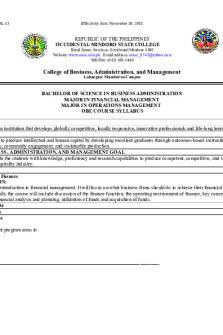Chapter 19-20 Notes PDF

| Title | Chapter 19-20 Notes |
|---|---|
| Author | Andy Chen |
| Course | Global Dimensions of Business |
| Institution | San José State University |
| Pages | 2 |
| File Size | 67.6 KB |
| File Type | |
| Total Downloads | 74 |
| Total Views | 163 |
Summary
Chapter 19-20 Notes...
Description
Study guide: chapters 19-20 Chapter 19: Global Human Resource Management 1. Human resource practices are focused on attracting, training, motivating, and retaining people. 2. Workforce planning, a key human resource practice in multinationals, is involved in recruitment and selection. 3. Goal setting, a key human resource practice in multinationals, is involved in performance management. 4. Succession planning, a key human resource practice in multinationals, is involved in training and development. 5. Critical behaviors are the few key areas of activity in which meeting strategic objectives are absolutely necessary. 6. Key performance indicators are clear-cut instruments to quantify whether individuals are on the right track to helping a company achieve its strategic objectives. 7. Local human capital consists of the knowledge, skills, abilities, and other attributes that make up the location-specific experiences of employees in a particular country or market. 8. Subsidiary human capital is company knowledge within a specific location. 9. Corporate human capital is knowledge about the policies, procedures, and goals that are constant across a company’s global operations. 10. Expatriates are employees assigned from a headquarters or another location to work in a foreign market. 11. Human resource (HR) professionals who work directly with top managers on strategic challenges play the first role of global HR, which is contributing to business decisions. 12. The key goal of those who fill the HR expertise role is to develop a deep level of expertise in an area such as change management. 13. Codetermination is cooperation between management and workers in decision-making, particularly by the representation of workers on boards of directors. 14. Payroll, benefits, and retirement are examples of human resource services. Chapter 20: Global Finance and Accounting 1. An open account agreement is a form of payment in which an importer doesn’t pay for goods until after they have been received, creating an unfavorable balance of value for the exporter. 2. In a documentary collection, an exporter’s bank is entrusted with collecting payment for goods. 3. Consignment is a process in which an exporter sends goods to an importer without transferring ownership. 4. Mutual funds are pooled and repackaged shares of various stocks—as well as other assets like bonds, real estate, and commodities—that allow individual investors to buy smaller stakes in more companies. 5. Contagion is a pattern in which stock markets have become increasingly interconnected around the world and markets in different countries have begun reacting similarly. 6. In the context of international investment, the cost of capital is the rate of return demanded by stock and bond investors. 7. The financial statements of publicly traded companies in the United States must be prepared according to the guidelines set forth in the Generally Accepted Accounting
Principles 8. The International Accounting Standards Board (IASB) is privately funded. 9. The International Accounting Standards Board (IASB) may not have the legal authority to enforce its rules. 10. Countries with no or low corporate taxes are called tax havens. 11. Andorra is an example of a tax haven. 12. Transfer pricing is the price charged when two parts of the same multinational corporation, often the parent company and a subsidiary in another country, engage in trade with one other....
Similar Free PDFs

1920-international-appeal
- 2 Pages

OS101 Tides Worksheet 1920
- 5 Pages

P2-1920 - Flutter
- 6 Pages

HEMaster BPM 1920 - lessen
- 11 Pages

Olimpiadi Anversa 1920
- 2 Pages

Basic Finance Syllabus 1920
- 10 Pages

Economy in 1920\'s essay
- 3 Pages

Ev AU IngléS 1920
- 32 Pages

1726486 MC3103 1920 - dissertation
- 91 Pages

1920 Seminar 1 questions
- 2 Pages

Practica 2inv PWMsin 1920
- 12 Pages

Practica TLP 1920
- 8 Pages

Max Weber (1864–1920)
- 17 Pages
Popular Institutions
- Tinajero National High School - Annex
- Politeknik Caltex Riau
- Yokohama City University
- SGT University
- University of Al-Qadisiyah
- Divine Word College of Vigan
- Techniek College Rotterdam
- Universidade de Santiago
- Universiti Teknologi MARA Cawangan Johor Kampus Pasir Gudang
- Poltekkes Kemenkes Yogyakarta
- Baguio City National High School
- Colegio san marcos
- preparatoria uno
- Centro de Bachillerato Tecnológico Industrial y de Servicios No. 107
- Dalian Maritime University
- Quang Trung Secondary School
- Colegio Tecnológico en Informática
- Corporación Regional de Educación Superior
- Grupo CEDVA
- Dar Al Uloom University
- Centro de Estudios Preuniversitarios de la Universidad Nacional de Ingeniería
- 上智大学
- Aakash International School, Nuna Majara
- San Felipe Neri Catholic School
- Kang Chiao International School - New Taipei City
- Misamis Occidental National High School
- Institución Educativa Escuela Normal Juan Ladrilleros
- Kolehiyo ng Pantukan
- Batanes State College
- Instituto Continental
- Sekolah Menengah Kejuruan Kesehatan Kaltara (Tarakan)
- Colegio de La Inmaculada Concepcion - Cebu


